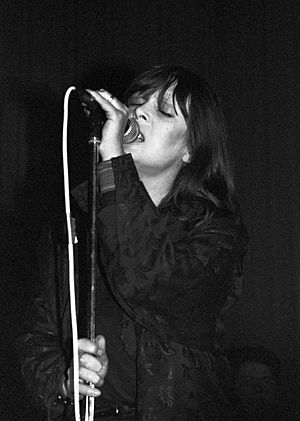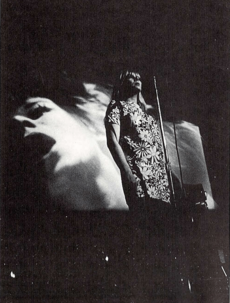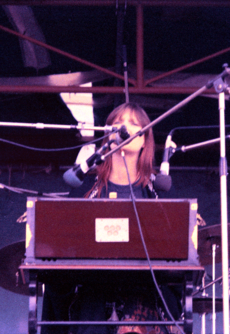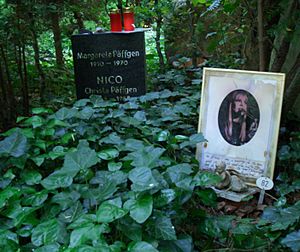Nico facts for kids
Quick facts for kids Nico |
|
|---|---|

Nico performing at the University of Wales, Lampeter, 1985
|
|
| Background information | |
| Birth name | Christa Päffgen |
| Born | 16 October 1938 Cologne, Germany |
| Died | 18 July 1988 (aged 49) Ibiza, Spain |
| Genres | |
| Occupation(s) |
|
| Instruments |
|
| Years active | 1954–1988 |
| Labels | |
Christa Päffgen (born October 16, 1938 – died July 18, 1988), known by her stage name Nico, was a German singer, songwriter, actress, and model. She appeared in several films, including La Dolce Vita (1960) by Federico Fellini and Chelsea Girls (1966) by Andy Warhol. A reviewer once described Nico as "half goddess, half icicle." They also said her unique voice sounded "something like a cello getting up in the morning."
Andy Warhol encouraged her to sing on three songs for The Velvet Underground's first album, The Velvet Underground & Nico (1967). Around the same time, she started her own music career. She released her first solo album, Chelsea Girl (1967). Her friend, Jim Morrison, suggested she start writing her own songs. Nico then began composing music using a harmonium, which was not a common rock instrument. John Cale from The Velvet Underground helped her with her music and produced many of her later albums. These included The Marble Index (1968), Desertshore (1970), and The End... (1974).
In the 1980s, Nico performed many concerts across Europe, the United States, Australia, and Japan. After a show in Berlin in June 1988, she went to Ibiza for a holiday. She died there after a cycling accident.
Contents
Nico's Early Life
Nico was born Christa Päffgen in Cologne, Germany. Her parents were Wilhelm and Margarete Päffgen. Her father's family were wealthy brewers in Cologne. Her mother came from a more humble background. When Nico was two, she moved with her mother and grandfather. They went to the Spreewald forest near Berlin to escape the bombings of Cologne during World War II.
Her father joined the German army at the start of the war. There are different stories about how he died. One account says he was badly wounded in 1942. Another story suggests he had severe brain damage and lived in a mental hospital.
In 1946, Nico and her mother moved to downtown Berlin. Nico worked as a seamstress. She went to school until she was 13. Then she started selling lingerie at a fancy department store called KaDeWe. Soon, she began getting modeling jobs in Berlin. Nico was tall, about 5 feet 10 inches (178 cm). She had sharp features and pale skin. She quickly became a well-known fashion model while still a teenager.
Nico's Music Journey
Becoming a Model and Actress
In 1954, when Nico was 16, photographer Herbert Tobias discovered her. They were both at a fashion show in Berlin. He gave her the name "Nico" after a filmmaker he admired, Nikos Papatakis. She used this name for the rest of her life. She moved to Paris and started working for famous fashion magazines. These included Vogue and Elle. Around this time, she changed her brown hair to blonde. At 17, she was hired by Coco Chanel to promote products. But she left for New York City instead. Through her travels, she learned to speak English, Spanish, and French.
In 1959, she was invited to the set of Federico Fellini's film La Dolce Vita. The famous director noticed her. He gave her a small role in the movie, playing herself. By then, she was living in New York. She was also taking acting classes with Lee Strasberg.
After a role in the 1961 film A Man Named Rocca, she appeared on the cover of jazz pianist Bill Evans' 1962 album, Moon Beams. She then got the main role in Jacques Poitrenaud's Strip-Tease (1963). She recorded the title song for this film. It was written by Serge Gainsbourg. The song was not released until 2001.
First Steps in Music
In 1965, Nico met The Rolling Stones guitarist Brian Jones. She recorded her first song, "I'm Not Sayin'", with "The Last Mile" as the B-side. Jimmy Page produced it. Actor Ben Carruthers introduced her to Bob Dylan in Paris that summer. In 1967, Nico recorded Dylan's song "I'll Keep It with Mine" for her first album, Chelsea Girl.
Joining The Velvet Underground
After meeting through Brian Jones, Nico started working with Andy Warhol and Paul Morrissey in New York. They made experimental films like Chelsea Girls. Warhol began managing The Velvet Underground, a rock band from New York City. He suggested that Nico join the group as a singer. The band agreed, even though they had some doubts.
The group became the main act of Warhol's Exploding Plastic Inevitable. This was a multimedia show with music, lighting, film, and dance. Nico sang lead vocals on three songs for the band's first album, The Velvet Underground & Nico (1967). These songs were "Femme Fatale", "All Tomorrow's Parties", and "I'll Be Your Mirror". She also sang backing vocals on "Sunday Morning". A reviewer said her voice on the album sounded "something like a cello getting up in the morning."
Nico's time with The Velvet Underground had some challenges. John Cale wrote that Nico's long preparations before shows often caused delays. This annoyed songwriter Lou Reed. The album became a classic over time. It is now ranked among the greatest albums ever. However, it was not very popular when it first came out.
Starting Her Solo Career
After working with The Velvet Underground, Nico began her solo career. She performed regularly at The Dom nightclub in New York City. She was often joined by different guitarists. These included members of The Velvet Underground, Tim Hardin, Tim Buckley, and Jackson Browne.
For her first solo album, Chelsea Girl (1967), she sang songs by Bob Dylan, Tim Hardin, and Jackson Browne. Velvet Underground members Lou Reed, John Cale, and Sterling Morrison also helped with the album. Nico, Reed, and Cale wrote one song together, "It Was a Pleasure Then." Chelsea Girl is a folk album with strings and flute. Nico had little control over how it was made. She was not happy with the final result. She said in 1981, "I still cannot listen to it... they covered it in flutes!" In California, Nico spent time with Jim Morrison of The Doors. He encouraged her to write her own songs.
For her next album, The Marble Index, released in 1968, Nico wrote all the lyrics and music. Nico's harmonium was the main instrument. John Cale added other folk and classical instruments. The harmonium became her signature instrument for the rest of her career. This album had a classical and European folk sound. It also marked a big change in Nico's look. She dyed her hair red and started wearing mostly black. This style later influenced the gothic rock music scene.
A music video for the song "Evening of Light" was filmed. It showed the red-haired Nico and Iggy Pop of The Stooges.
In the early 1970s, Nico started performing live again. She played concerts in Amsterdam and London. She and John Cale opened for Pink Floyd. In 1972, Nico, Cale, and Lou Reed had a special reunion concert at the Bataclan in Paris.
Nico released two more solo albums in the 1970s: Desertshore (1970) and The End... (1974). She wrote the music, sang, and played the harmonium. Cale produced and played most of the other instruments. The End... featured Brian Eno and Phil Manzanera from Roxy Music. She performed a version of The Doors' song "The End." This song inspired her album of the same name.
Between 1970 and 1979, Nico made about seven films with French director Philippe Garrel. She met Garrel in 1969. She contributed a song to his film Le Lit de la Vierge. Soon after, she lived with Garrel and became important in his films and personal life. Nico's first acting role with Garrel was in his 1972 film, La Cicatrice Intérieure. Nico also provided music for this film. She appeared in other Garrel films, including Les Hautes Solitudes (1974) and Le Berceau de cristal (1976).
Around this time, Nico worked with musician Lutz Ulbrich. He played guitar with Nico at many of her concerts. Nico also let her hair return to its natural brown color. She continued to wear mostly black. This became her public image from then on.
Later Years and New Sounds
In September 1978, Nico performed at the Canet Roc '78 festival in Spain. Other bands like Blondie also played there. She sang on Neuronium's second album, Vuelo Químico. She read parts from "Ulalume" by Edgar Allan Poe. She said the music moved her deeply. That same year, Nico briefly toured as a supporting act for Siouxsie and the Banshees. In Paris, Patti Smith bought Nico a new harmonium after hers was stolen.
Nico returned to New York in 1979. Her comeback concert at CBGB was praised by The New York Times. She started playing regularly at the Squat Theatre. She was often joined by Jim Tisdall on harp and Gittler guitar. They toured together in the East and Midwest.
In France, Nico met photographer Antoine Giacomoni. His photos of Nico were used for her next album. Nico recorded her next studio album, Drama of Exile, in 1981. It was produced by Philippe Quilichini. This album was different from her earlier work. It mixed rock music with Middle Eastern sounds. For this album, Nico covered The Velvet Underground's "I'm Waiting for the Man" and David Bowie's "Heroes".
Nico moved to Manchester, England, in the early 1980s. She got a manager, Alan Wise. She started working with different backing bands for her many live shows. These bands included Blue Orchids and The Faction.
In 1981, Nico released the single "Saeta"/"Vegas". The next year, she released "Procession". This single included a new version of The Velvet Underground's "All Tomorrow's Parties".
Nico toured in 1982 with the band Blue Orchids. Her music influenced the growing gothic rock scene. At Salford University in 1982, she performed "I'm Waiting for the Man" with Bauhaus. That same year, bands like The Sisters of Mercy opened for Nico. After working with Blue Orchids, she hired James Young and his band, The Faction, for her concerts.
She recorded her last solo album, Camera Obscura, in 1985. She worked with The Faction. John Cale produced it. The album included Nico's version of "My Funny Valentine". The last song on the album was "König." This was the only song on the album sung in German. A music video for "My Heart Is Empty" was filmed.
In her final years, Nico performed live often. She toured Europe, Japan, and Australia. Many of her later performances were recorded and released. These included Heroine and Behind the Iron Curtain.
In March 1988, she and James Young hired a new guitarist, Henry Olsen. They wrote new songs to perform at a festival in Berlin in June. Nico was inspired by Egyptian music and the singer Oum Kalthoum. Young said the new songs were good enough for a new record with an Egyptian orchestra. The Berlin concert ended with "You Forget to Answer."
Her last studio recording was a duet called "Your Kisses Burn" with singer Marc Almond. It was released after her death on Almond's album The Stars We Are. The recording of her 1988 Berlin concert was later released as Nico's Last Concert: Fata Morgana.
Nico's Life Outside Music
Nico had a relationship with French actor Alain Delon. On August 11, 1962, she gave birth to their son, Christian Aaron Boulogne, whom she called Ari. Ari later became a photographer and actor. He has a son and a daughter.
Nico saw herself as a bohemian artist. She lived a nomadic life, moving between different countries. Besides Germany, where she grew up, she lived in Italy and France in the 1950s. She spent most of the 1960s in the US. She also lived in London in the early 1960s and again in the 1980s. Her final years were spent in the Manchester area of England.
Death
On July 17, 1988, Nico was on holiday with her son Ari in Ibiza, Spain. She fell off her bicycle and hit her head. A taxi driver found her unconscious. She was taken to local hospitals. Doctors first thought she was suffering from heat exposure. She was declared dead at 8:00 pm. Later X-rays showed that a severe cerebral hemorrhage (bleeding in the brain) was the cause of death.
Nico's cremated remains are buried in her mother's plot. This is in Grunewald, a forest cemetery in Berlin. Friends played a song called "Mütterlein" at her funeral.
Legacy
Nico inspired many musicians. These include Siouxsie and the Banshees, The Cure, Morrissey, Elliott Smith, and Björk. Siouxsie and the Banshees invited her to be a special guest on their first big UK tour in 1978. They also covered her song "All Tomorrow's Parties." Robert Smith, the leader of The Cure, said Desertshore is one of his favorite albums. Björk also loves it. Peter Hook of Joy Division said Chelsea Girl is one of his favorite albums. Peter Murphy, the singer of Bauhaus, thought Nico recorded the first truly Gothic album. Morrissey also named Nico as an artist who had a lasting influence on him. Elliott Smith covered "Chelsea Girls" and "These Days". Marc Almond recorded a cover of "The Falconer." He said he was obsessed with her "wonderful intriguing voice." Patti Smith performed a tribute concert to Nico in 2014. Low wrote a song called "Those Girls (Song For Nico)." Neko Case covered "Afraid" in 2013.
Marianne Faithfull recorded "Song For Nico" on her 2002 album "Kissin' Time."
Two of Nico's songs from Chelsea Girl, "The Fairest of the Seasons" and "These Days," were in Wes Anderson's film The Royal Tenenbaums.
Several books and films have been made about Nico's life. The first book was Songs They Never Play on the Radio (1992) by James Young. He wrote about his time with Nico in her last years. In 1993, Nico: The Life and Lies of an Icon by Richard Witts covered her whole life. The 1995 documentary Nico Icon explored her life. It included stories from people who knew her. In 2018, the movie Nico, 1988 was released. Trine Dyrholm played Nico in the film.
In 2019, the Manchester International Festival presented The Nico Project. This was a play based on Nico's 1968 album The Marble Index. Maxine Peake starred in it.
In 2021, the book "You Are Beautiful and You Are Alone: The Biography of Nico" by Jennifer Otter Bickerdike was released.
Tributes
Many concerts have been held to honor Nico's music. In 2005, the band Anberlin released a song called "Dance, Dance Christa Päffgen," inspired by Nico. In autumn 2008, two tribute concerts took place in Europe. These marked 70 years since Nico's birth and 20 years since her death. On October 11, 2008, John Cale, James Dean Bradfield, Fyfe Dangerfield, Mark Linkous, Peter Murphy, Lisa Gerrard, and Mark Lanegan performed in London. On October 17, 2008, Nico's former musical partner Lutz Ulbrich presented another tribute concert in Berlin.
Performance artist Tammy Faye Starlite created a one-woman show called "Nico: 'Chelsea Mädchen'." She played Nico and used parts of an interview Nico gave in the 1980s.
In 2012, X-TG released a new version of the Desertshore album.
In January 2013, John Cale organized a tribute concert called A Life Along the Borderline in New York City. Many artists performed, including Cale, Kim Gordon, Sharon Van Etten, and Peaches.
The song "Last Ride" on Beach House's 2018 album 7 was inspired by Nico.
Discography
Nico released several studio albums, live albums, and singles.
Studio albums
| Year | Title |
|---|---|
| 1967 | The Velvet Underground & Nico |
| 1967 | Chelsea Girl |
| 1968 | The Marble Index |
| 1970 | Desertshore |
| 1974 | The End... |
| 1981 | Drama of Exile |
| 1985 | Camera Obscura |
EP
| Year | Title |
|---|---|
| 1977 | The Peel Sessions |
Live albums
| Year | Title |
|---|---|
| 1972 | Le Bataclan '72 (With John Cale and Lou Reed) |
| 1974 | June 1, 1974 |
| 1982 | Do or Die: Nico in Europe |
| 1983 | Live in Denmark |
| 1985 | Nico Live in Pécs |
| 1989 | Nico in Tokyo |
| 1990 | Hanging Gardens |
| 1992 | Chelsea Girl / Live |
| 1994 | Heroine |
| 2022 | Live at the Hacienda '83 |
Compilation albums
| Year | Title |
|---|---|
| 1984 | Live Heroes |
| 1998 | Nico: The Classic Years |
| 2003 | Femme Fatale – The Aura Anthology |
| 2007 | The Frozen Borderline – 1968–1970 |
Singles
| Year | Title |
|---|---|
| 1965 | "I'm Not Sayin'" / "The Last Mile" |
| 1981 | "Saeta" / "Vegas" |
| 1982 | "Procession" / "All Tomorrow's Parties" |
| 1983 | "Heroes" / "One More Chance" |
| 1985 | "My Funny Valentine" / "My Heart Is Empty" |
Films and Plays
Nico appeared in several films and inspired plays.
- Nico – In Memoriam (1988), a documentary
- Nico Icon (1995), a documentary
- Nico Icon Play, a play by Stella Grundy (2007)
- Nico. Sphinx aus Eis (2005), by Werner Fritsch
- Nico, 1988 (2018), a movie with Trine Dyrholm as Nico
- The Nico Project (2019), a theatrical show
|
See also
 In Spanish: Nico (cantante alemana) para niños
In Spanish: Nico (cantante alemana) para niños





